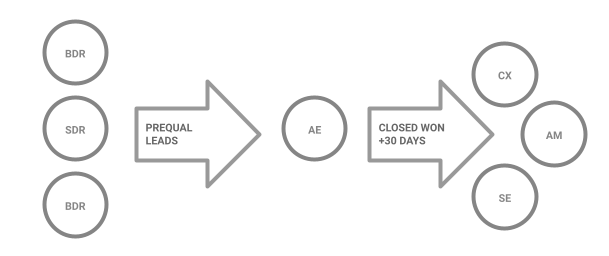The average tenure of sales leader in SaaS and tech hovers right around 18 months. One or two bad quarters, regardless if there were macro issues or marketing stumbled – off you go! That never sat well with me because I started my career in sales as a talent agent in the entertainment industry, and I have respect for the sales craft. Even after I pivoted to my true passion for operations and finance, I have always positioned myself close to the sales teams. While projections, financial models, operational systems, etc., are areas of my depth, I do get involved in sales management more often than not. In earlier stage ventures, I found that if I build good foundations for the sales team, I can recruit an exceptional sales leader and help them succeed. Wouldn’t you know, if you are helpful, people are happy to build with you and share some of their tricks.
In this post, which will be part of the series on team revenue methodologies and processes, I want to share the team structure I worked on with my colleague Jamie Willson, a former VP of Sales at the company I co-founded – Robin. I liked what, when implemented, this sales team structure did to the team KPIs and the quality of the revenue (high NetRRR). While the version in this post may differ from what Jamie practices, I had retained key elements and adapted only ones I wanted to evolve further.
Structuring the sales team into the Sales Pods
Why Sales Pods? What are we trying to address?
- While it is possible to build a strong revenue stream treating sales as an “individual sport,” I have found customers closed by and cared for by a team with, using the medical term, continuity of care had measurably lower churn and higher contract expansion.
- Quota attainment can have wild variances, and it isn’t always due to individual talents. When team members are re-focused on how they affect the team, when they feel safe and motivated to share their knowledge and collaborate, quota attainment becomes more predictable and consistent.
- When a team owns leads and customers, sellers do not engage in typical hoarding behavior. Hence, the usual issues with stale leads, missed deals, and underserved accounts aren’t an issue. There is a lot of power in collaborative selling. The final results reflect very positively in CAC and LTV.
- The seller’s time and prospect’s/customer’s attention are limited resources. Given those limitations, any missed or inefficient sales activity has a negative and compounding effect. Team discipline tends to be a lot more effective than one driven by a manager.
The basics of the Sales Pods:
- Sales Pods are comprised of sellers with clear roles, responsibilities, and timed sales activity. A straightforward process defines continued care of every lead, deal, or contract.
- When scaling teams, Sales Pods are replicated instead of expanded.
- Any process, methodology, training, or compensation changes are in sync between all Pods except for the experimental Sales Pod, where the whole team is clear on their role in a discovery mission.

Composition of the Sales Pods:
- Business Development Representatives (BDR) – these sellers may be contract/outsourced or in-house. 100% focus on outbounding and lead discovery. The role is optional if SDRs are outbounding 75% of the time or more. Caveat: only in-house BDRs partake in the team compensation pool.
- Sales Development Representatives (SDR) – 100% in-house role. Sellers in this role are responsible for pre-qualifying all the inbound sales leads and then filling the rest of their available time with outbound prospecting activity. 50%/50% inbound/outbound ratio is excellent.
- Account Executives (AE) – the moment SDRs establish product/prospect fit, AEs spring into action. Sellers in this role take the prospect through a sales journey to closed-won and then time-limited (30-60 days) post-close sales activity.
- Account Managers (AM) – these sellers take on a concierge role and are responsible for customer’s experience. AMs own the responsibility for retention, renewal, and contract expansion.
- With scale (or complexity of the product), Sales Pods may get dedicated sales engineers, customer experience, or onboarding representatives. I am a big fan of dedicating said professionals to Sales Pods because I can account for COGS, CAC, and project costs in general much more accurately.
Compensation:
- While your sales and compensation model may differ, the head of sales should have complete autonomy to adjust compensation as and when they see it most effective. Sometimes they will spend the budget, and sometimes they will keep a portion of it saved for a later payout based on special campaigns. Yes, when we need the sales teams to take on specific missions, like a push for more logos, contract expansion, new product launches, or other results necessary for the company’s situation. Those missions should have a separate budget.
- Variable compensation within Sales Pods, outside of special team missions, should have consistently shared ratios. We found 50% individual performance and 50% team performance ratio was a good split. If the process is new to the company, you may want to try a different percentage. 25% individual/75% team split during the warm-up to the process. 75%/25% split when the process and teams become mature and consistent in their monthly or quarterly performance.
- As mentioned earlier, the compensation structure between multiple Sales Pods should be the same, and so should missions for special bonuses. Different treatment of Sales Pods causes politics, lousy competition, and a toxic environment. Please don’t do it!
Details of continuity of care within Sales Pods:
- BDR identifies a prospect or inbound lead comes into SDR. BDR/SDR enriches the lead information to the point for AE to confidently start the discovery and sales process.
- AE takes on the lead, at which point we should diligently measure/time the process. Deals within prospect/customer cohort tend to close within similar timeframes. If at any point AE loses deal velocity, another AE may need to step in. Prospect attention is a very scarce resource.
- Once the deal is closed-won, AE, in parallel, looks for opportunities to expand the contract while the customer is onboarding and is transitioning to care of AM. During this time of handover, we discover if AM is the best fit for said customer. Because the team is accountable for the customer’s care, culturally, there is less friction when we find out one AE may be a better chemistry fit with the customer than the other.
- AE takes over the customer and is now a concierge for them for the business relationship duration. Contract expansion, customer satisfaction, new product introductions, renewals – the responsibility of the AE.
Note on accountability:
You probably heard the saying that the team recognizes the potential and discovers unfit members way before the manager can. Team members will feel more accountable and disciplined in an environment where a large part of their compensation depends on the team’s performance. At least, that is what I have observed.



